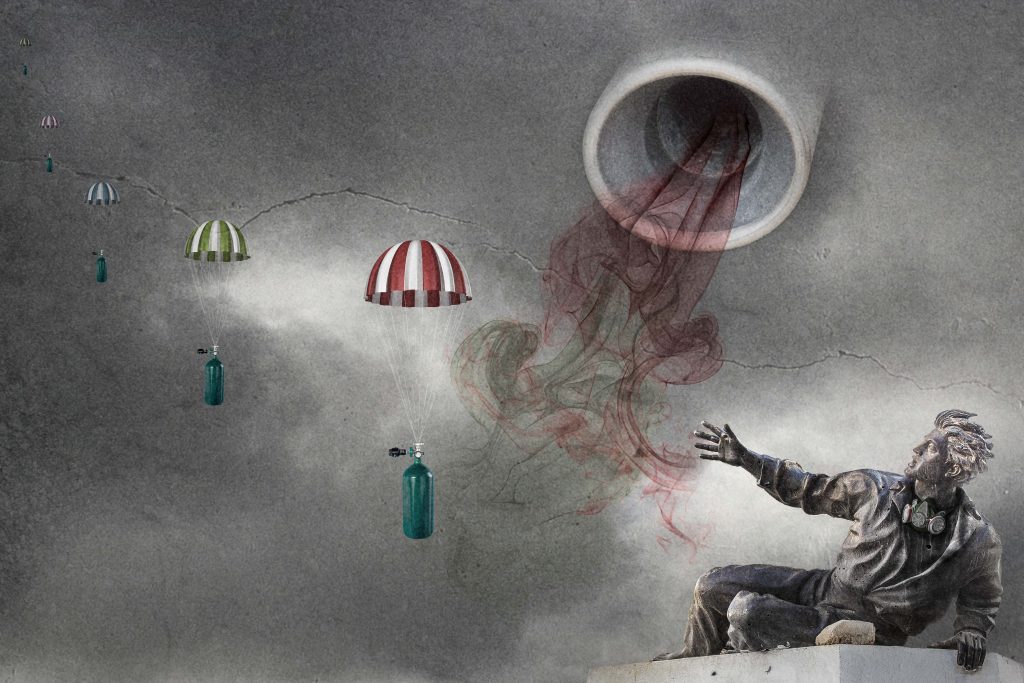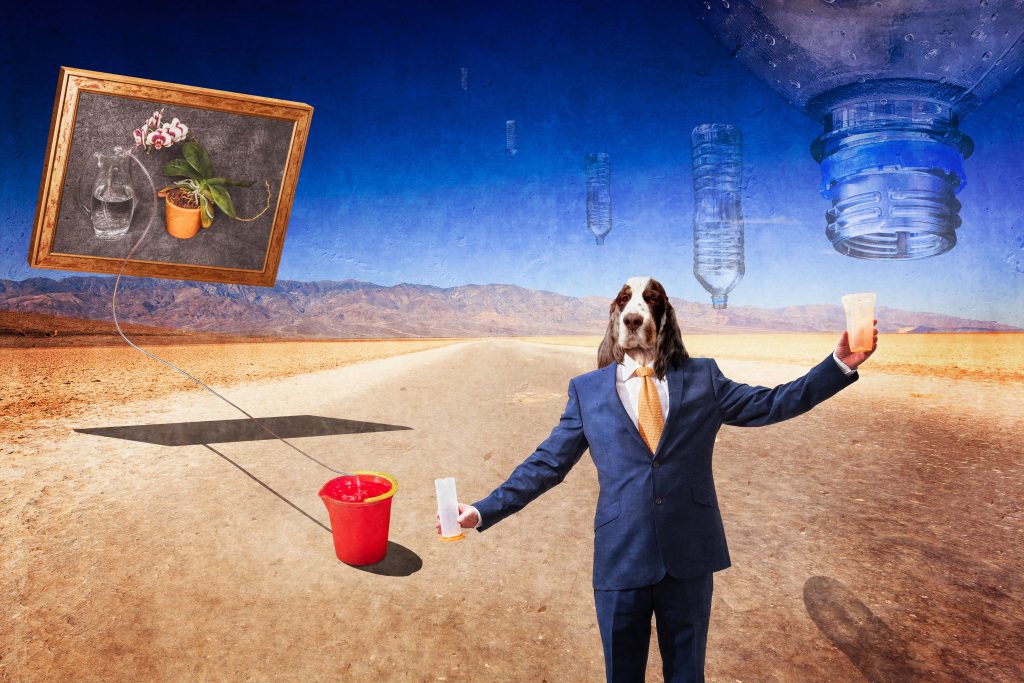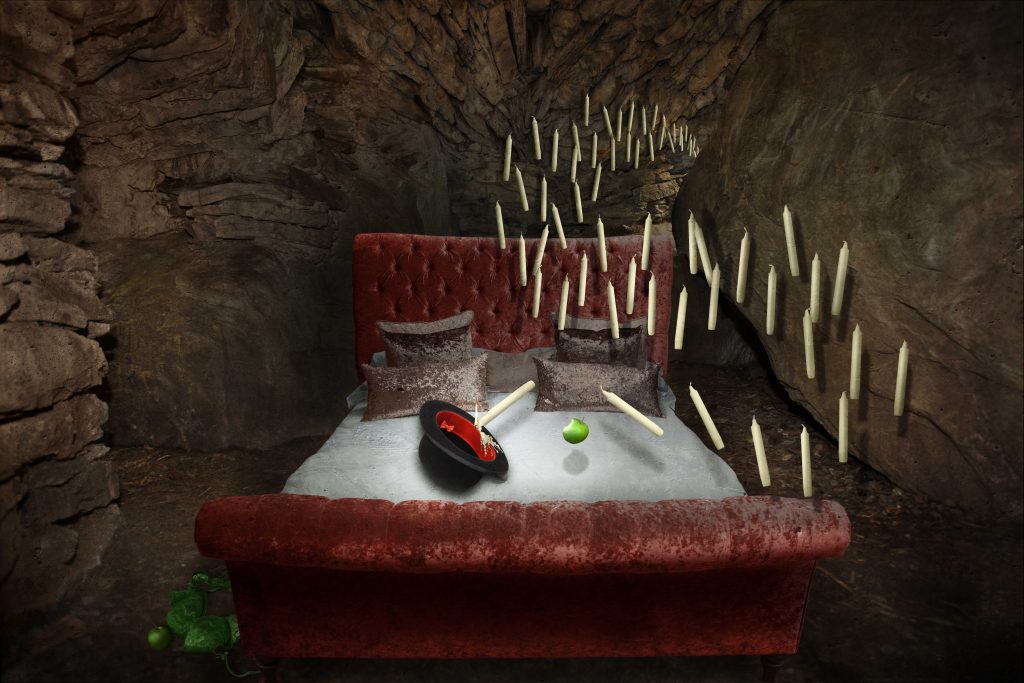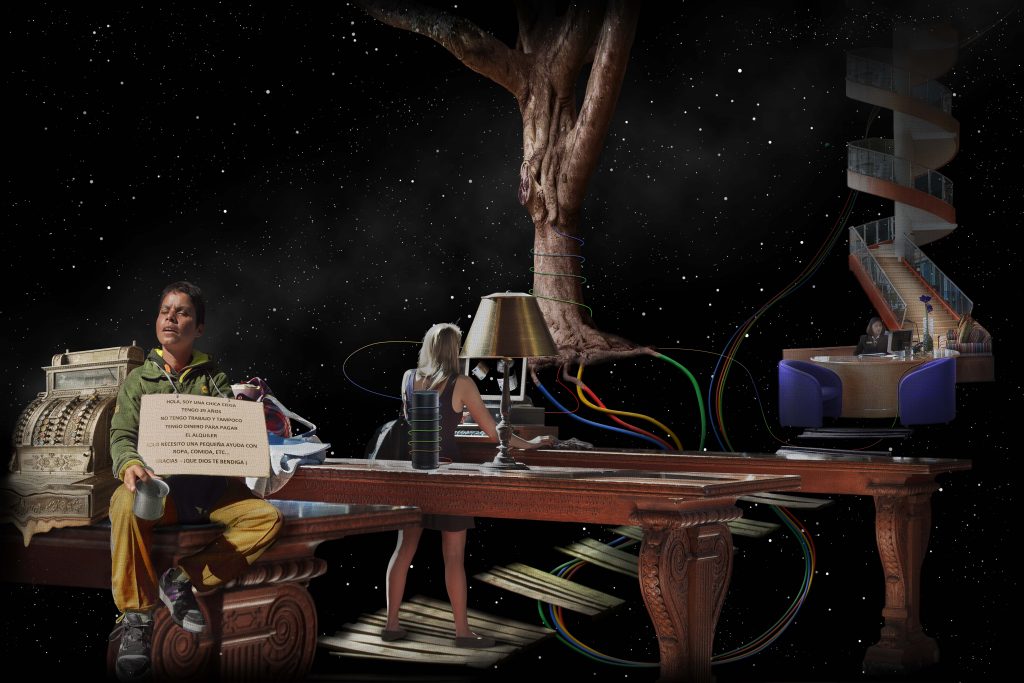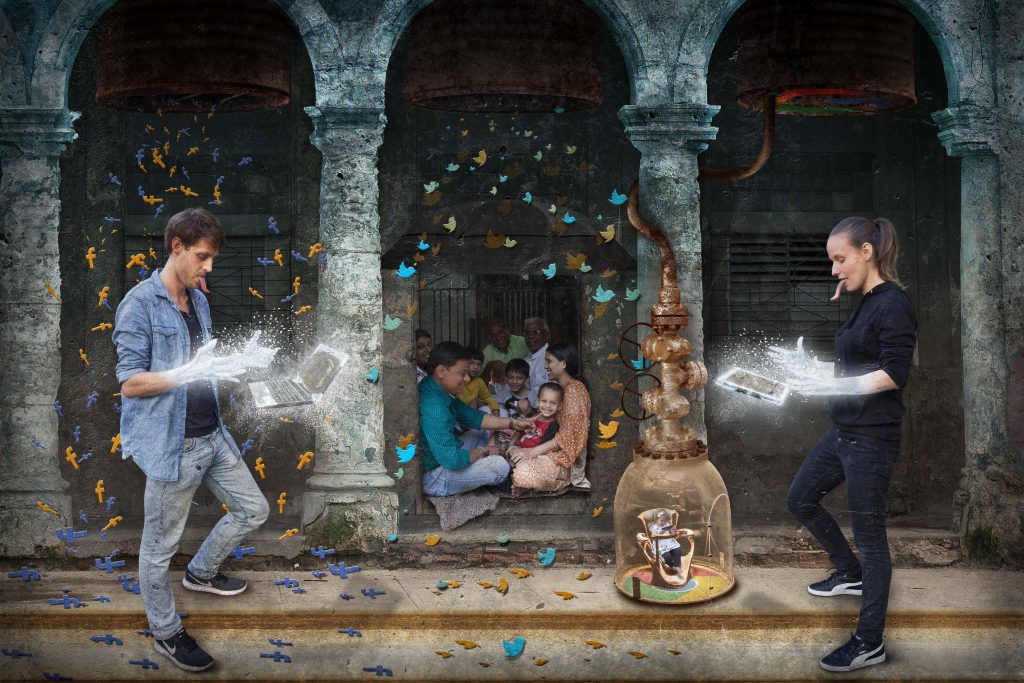Hope: Ten images depicting Maslow’s Hierarchy of Needs in surrealist form
By George Berrie
The artist says
I am doing this because the world needs hope. With hope we can overcome the onslaught of constant negative messages from traditional and new media which can cause us despair. With hope, we can overcome the paralysis of worry, a habit we can get into which serves no useful purpose and can even make us ill. Hope can help us overcome the challenges of mental illness, something which has become an increasing problem since the global pandemic which started in 2020. Most importantly, hope creates a feeling of expectation and that can create the desire to achieve the very thing we hope for. And it is desire, not ability, that determines our success.
George Berrie
This exhibition, which forms part of our ‘Art of Wellbeing‘ series of exhibitions this year, is currently on display in Gallery Three of the Pathfoot Building. It explores ‘Hope’, and each image conveys an element of Maslow’s theory, beginning with our need for fresh air, clean water, nutritious food, shelter, sex, etc., and eventually through to what Maslow called ‘self-actualisation’. Hope comes from the fact that we can reach higher levels of being and that this hope creates an expectation. In turn, that expectation can lead to a desire to reach that higher level. Desire to reach a goal, rather than raw ability, is what the artist believes is the key element of personal success.
1 Our need for fresh air
The subject in the image, desperate for fresh air in an increasingly polluted planet, is taken from a statue in Martyr’s Square in Beirut, Lebanon – a place that is no stranger to war and today is facing struggle once again. It was whilst in Beirut that the artist had the inspiration to tackle a portfolio of ten surrealist images depicting Maslow’s hierarchy of needs.
The parachutes were drawn digitally, as was the polluting smoke. The disparate elements are unified by using textured layers, mostly comprising images of concrete. The image is simple with few elements, reflecting the most basic need identified by Maslow.
2 Our need for clean water
The amount of digital drawing and painting has increased with this image. Practice from drawing with traditional materials helped the artist develop his skills with a digital paintbrush, applying pixels onto a digital canvas..The image is a little more surreal than the first image. It depicts that even if humans can be ‘successful’ in some ways, their need for water is just as critical as that of a plant or an animal. As in the first image, there are signifiers of pollution, namely, the ubiquitous plastic water bottles. Images of concrete and fabric were used as texture layers to unify the elements. The background was shot in Badwater Basin, Death Valley, California – a place 85m below sea level and the lowest point in North America. Being a salt flat, any pools of water are undrinkable.
3 Our need for nutritious food
The level of surrealism has increased with this image. Some of the man’s fingers have been replaced by kitchen utensils attached by small magnets. Technology, albeit basic, is now part of his being. The artist was inspired by the views of Canadian Philosopher Marshall McLuhan, whom he learned about from his Digital Media studies at Stirling University. The subject needs nutritious food, but the plastic around the bacon becomes a barrier. Nearby a blind pig rummages for scraps of food amid a pile of rubbish. Like the first two images, there is the presence of pollution in the work. Are our three basic needs being increasingly compromised by modernity?
The subject in the image was shot in Cape Town, South Africa. The pig, and the plastic it was eating, were shot in Delhi, India when the artist was enroute to a technology training bootcamp in the Himalayas.
4 Our need for sex and shelter
Maslow’s two topics of humankind’s need for shelter and sex are combined into one image and continues the path of an increasing surrealist style as the theory becomes more abstract. The image reflects a deeper study of colour theory, particularly how complementary colours work, and the effect of colour in classic paintings.
Rene Magritte’s surrealist work The Restless Sleeper inspired the artist regarding the use of candles and a bowler hat – they are classical Freudian symbols of the male and female sexual parts. Other imagery represents the womb, the flow of sperm to the uterus, and the green apples of original sin.
5 Our need for physical security
The narrative of this image tells the story of past and present dangers from war, but equally, guns and justice can provide physical security too. The overall theme of hope arises in an otherwise bleak environment. In the background there is the former Nazi concentration camp at Auschwitz-Birkenau in Poland, with the Nazi flag drawing historical parallels with the ISIS flag. In the foreground, the shoes are located on the bank of the river Danube and honour the people who were killed by the Hungarian Arrow Cross Party, who shot Jews adjacent to the river during World War II. To the right of the shoes are metal faces, photographed in Berlin, representing the millions of Jews murdered during World War II, alongside actual Zyklon B canisters used in the gas chambers, the Nazi helmet, and the prosthetic limb, these latter items all from Auschwitz-Birkenau. The faces along the wall are from the Memorial to the Victims of Fascism in Krakow, Poland, with the fourth figure from the left pointing to our bloody modern times, illustrated by The National September 11 Memorial (Ground Zero) in New York. The subject, photographed in Madrid for this image, rises into the light, giving us hope in the form of justice, symbolised from the object she holds, and from the security of the bullets surrounding her.
6 Our need for economic security
The narrative of the image is that poverty can be overcome through gaining of knowledge, developing the collection’s theme of ‘hope’. Moving from left to right, we see the transition from a place where there is not even enough money for food or clothes, through to the subject accessing information, and finally to prosperity and employment on the right for those who have gained knowledge. The ancient cash register on the left, juxtaposed with the impoverished young woman, signify the long-standing importance of money. Images of various international currencies on the computer screen point to the global pursuit of prosperity through learning, with red, green, blue, and yellow colours signifying that pursuit through the western world’s most powerful search engine, which has become the ‘go to’ portal for all knowledge – good, evil, or otherwise. The use of the colour purple on the right, the opposite side of the colour wheel to yellow, signifies wealth. The artist again shows women in the ascent in western society and narrates their journey to economic security through both learning and adopting positions of power. The purple reception area and stairs were shot in Dubai, the wooden steps were shot in South Africa, and the subject in the power pose was shot in New York. The blind subject and ancient cash register were shot in Madrid. There are two hidden codes in this image – only visible when viewed in close up. Their binary nature signifies not only how we access knowledge in modern times but also how much of what we experience in our world is dependent on digitization. We are all digital citizens, wittingly, or unwittingly. If you want to have a go at finding and deciphering the hidden codes in this image, zoom in on it.
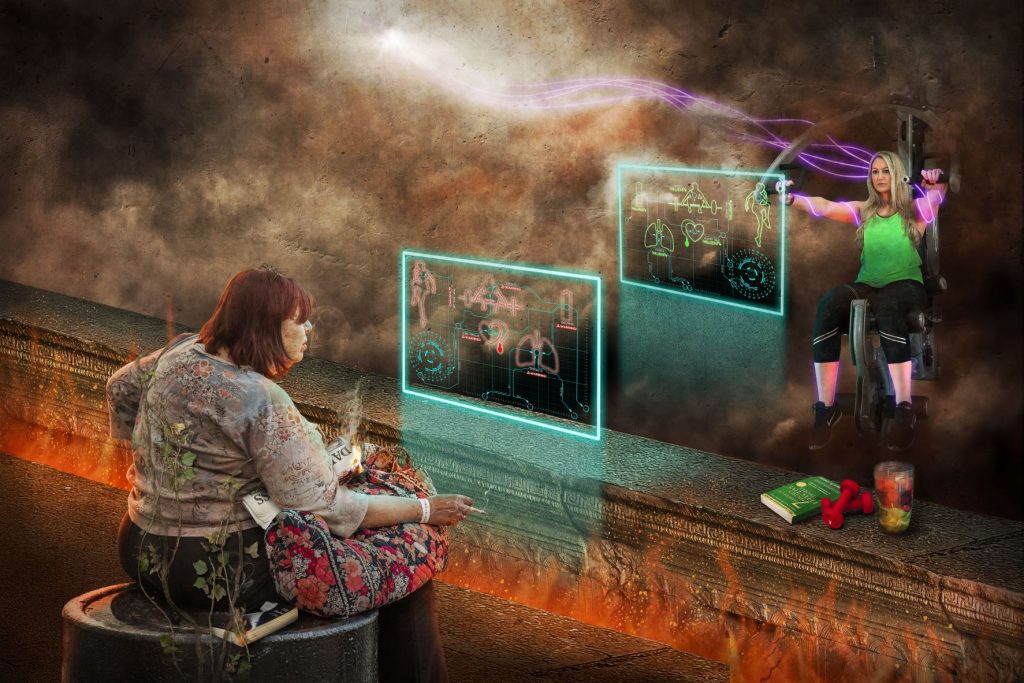
7 Our need for health & wellbeing
Moving from left to right, the narrative sets out the differences which arise from looking after, or not looking after, ourselves. It suggests our mental and physical wellbeing is a product of feeding our minds and bodies with helpful content, or unhelpful content. The reading materials signify alternatives of ‘food for the mind’. The choice of nutritious food, drink, and reading material, positioned on the youthful side of the dichotomy presented in the image, suggest the modern day focus on good physical and mental health by many young people. Dangerous health consequences of bad choices are taken to the ultimate level, death, signified by the skull, face-to-face with the older, unhealthier subject. The lack of exercise and movement are shown by the ivy growing over their body. The subject also wears a wrist band indicating that she has had a heart bypass from eating at The Heart Attack Grill in Las Vegas, which sells the “World’s Highest Calorie Burger”. The main colour palette is a blend of complementary colours: oranges, greens and bluish purples – so continuing elements of the colour palette from the previous image. The images were shot in Rome (stone face of the wall), Munich (the upper surface of the wall), Las Vegas (the subject on the left), and The Hague (the skull).
8 Our need for love & social belonging
One narrative in this image presents two protagonists in the foreground, our gaze drawn to their symmetry, frosty hands, expressions of desire, and the distance between them. The cold nature of the technology points to its effect on its users, its coldness overcoming human warmth. Signifiers of electronic social media and technology companies rain down from three large rusty barrels, suggesting a potentially corrosive source, and littering the social environment with an abundance of messages. The tiny subject covered by the bell jar and industrial pipework, whilst signifying that the smallest of human beings appear shielded from the influence of social media at a tender age, are nevertheless trapped by the ubiquitous nature of the technology and seem comfortable at using the devices that connect to it. In the background, another narrative plays out, perhaps in a different time and place, in which family values, physical closeness, happiness, and an absence of technology contrast with the world upon which they look. An umbrella signifies shelter for them from the effects of social media as the signifiers of such media are not present in their immediate environment. The mise-en-scène conveys family love, real contact, togetherness, warmth, social belonging, contentment, and even happiness. They have achieved, with hardly any material resources, what many of us in the west with an abundance of resources are failing to achieve. In a world of ‘digital haves and have-nots’, is digital poverty all that bad? The main colour palette is a blend of complementary and split-complimentary colours: mainly blues and oranges, thus continuing some elements of the colour palette from image seven. The image of the lower step was shot in Vienna and is part of the Schönbrunn Palace and the arches were shot in Havana, Cuba. The chair was shot in Lyon and the mechanism emanating from the bell jar was shot in Abu Dhabi. The subjects in the foreground were shot in the Merchant City in Glasgow and the family in the background was shot on a train between Delhi and the Himalayas.
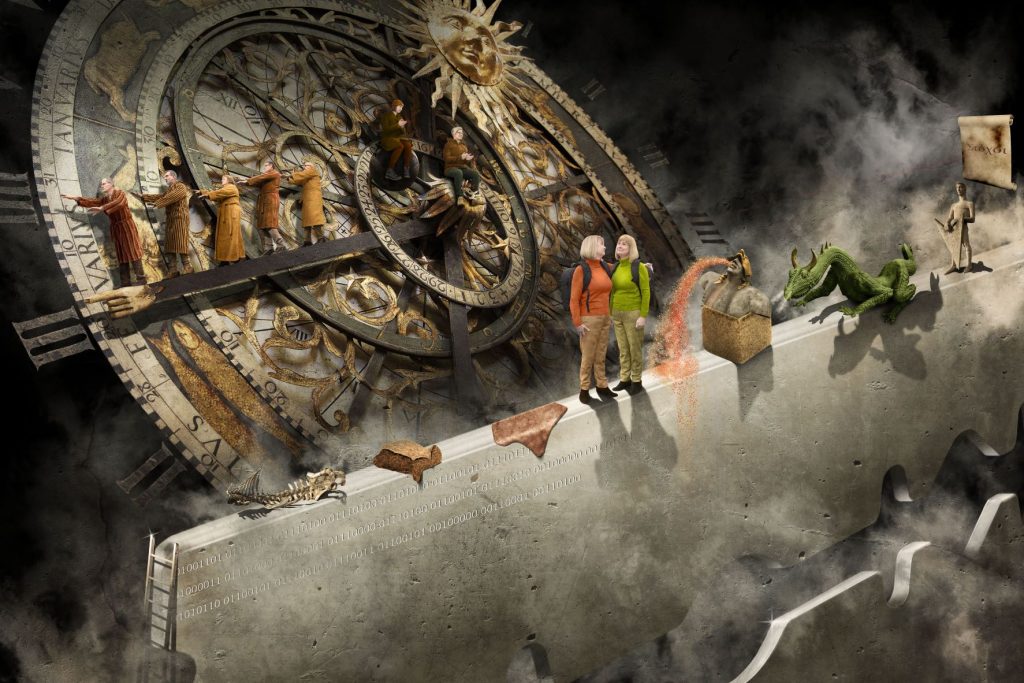
9 Our need for self-esteem
The narrative of this image represents the penultimate level of Maslow’s hierarchy of needs and is based on our need for self-respect, self-esteem, and the respect of others. The ideas for this image largely came from Nathaniel Branden’s book “The Six Pillars of Self Esteem”, which has been described as the ultimate work on self-esteem. Again, women are shown in ascendancy by making the central subject female and those sleepwalking through life to be largely male. The ladder to the left of the razor blade signifies that the central subject has achieved some elevation in her life. The razor blade signifies that the path is narrow, its sloping trajectory representing the uphill challenge for those that would seek self-actualisation. In contrast, the downward slope of the clock arm, and those sleepwalking through life along it, signifies the easy path, the herd culture, and that time is running out as they reach the end of the road. The skeleton and deformed shapes on the narrow path to success represent obstacles that the main protagonist has already overcome, while the figures ahead of her represent future challenges still to come. The dragon signifies unexpected and unusual challenges ahead, with the stone man signifying those who are simply ready to block her way. Nevertheless, as she embraces her self-image and her flaws, she remains focused on her goals in the distance, signified by a faint red laser. The skeleton was shot in Sambona, South Africa and the dragon was shot in Singapore. The clock and the stone man with the shield were both shot in Lyon and the two-faced man was shot in Berlin. The deformed images, the fiery sparks, and the clouds were all painted digitally. The elements within the image are again unified using textured layers of images of concrete, and additionally for this image, certain features in the concrete, such as cracks, were strategically placed to help guide the viewer’s gaze. Again, there is a code for inquisitive viewers to investigate. Feel free to take a photo of the image on your phone and zoom in on it.
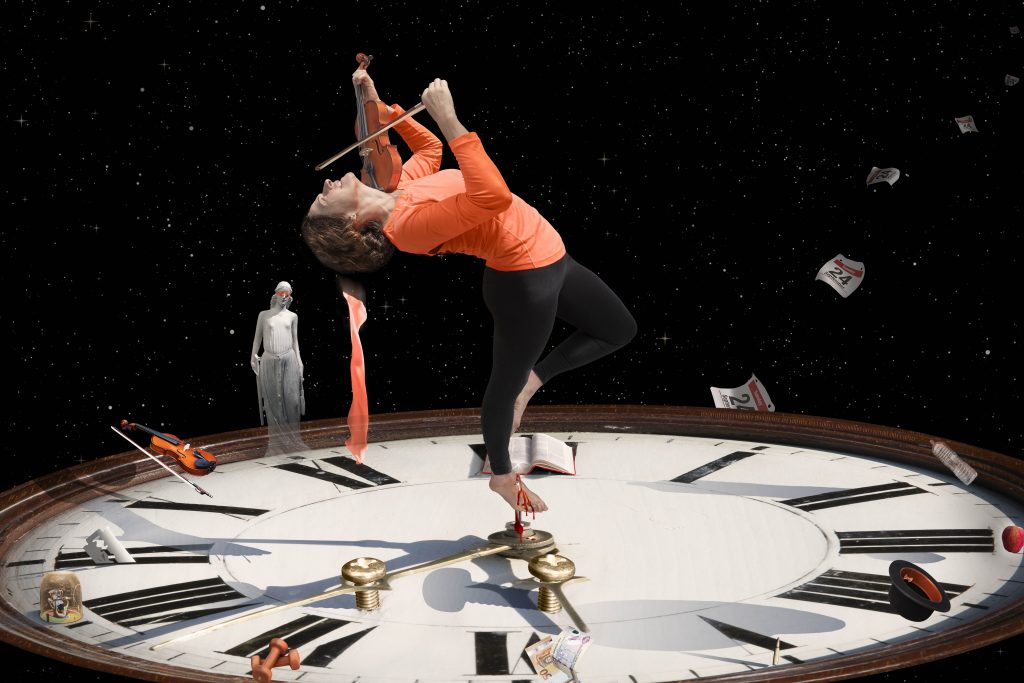
10 Our need for self-actualisation
“Maslow claimed, rightly in my view, that self-actualisation was ‘fleeting’ and expressed as ‘peak experiences’. It takes a great deal of skill and persistence to get to the mastery that gives you such peak experiences. That persistence can be painful. I’ve tried to express the fleeting nature of such experiences with the subject balancing on a single point – a progression from the last image which was the subject travelling on a very narrow path, a thin line. During a peak experience, the subject often feels as if time passes very quickly, or that they are not aware of time passing at all.”
The hands of the clock, bolted down at an immovable angle, signify time standing still, whilst the calendar pages all show the same date. The icons around the clock represent each of the previous needs, and are taken from the previous images in the collection. Positions 11 and 12 on the clock represent Maslow’s revisiting of his theory to introduce the idea of transcendence and spirituality arising as ‘needs’ even when one appears to ‘have it all’. At clock position 11, a ghost-like image of the blindfolded Synagoga appears and the subject in the centre of the image represents Ecclesia, whose blindfold has fallen away. Both Synagoga and Ecclesia appear in medieval Christian art, with and without a blindfold respectively, signifying the former’s unwillingness to recognise a Messiah. At clock position 12, a sacred text signifies our need for transcendence. The Synagoga figure was shot in Berlin and was one part of a two-piece sculpture, the other being Ecclesia. The clock is over 200 years old and was shot in Scotland when the sun was very low. The spike going through the subject’s foot is an old shower pole and the hole in the subject’s foot was part of a prosthetic used in a film set in Lyon. The colours for this image are analogous to symbolize harmony, rather than the sense of ‘opposites’ from the use of complementary colours used in the earlier images.
A final code is present in this image, for those who can find it.
On the artist:
George Berrie was born in Fallin, near Stirling, where he grew up in relative poverty in the 1960s. After leaving school he went to Heriot Watt University to read actuarial mathematics but became disillusioned and joined an insurance company to earn money. At 39 he became the CEO of the largest insurance company in New Zealand, and a few years later he was appointed to the board of Norwich Union, then became a director with Aviva.
The ‘golden spur’ to escape his childhood poverty, having done its job, caused him to reflect on future goals. It was at this point that he was inspired to do an arts degree at Stirling University, relinquishing his business roles and becoming a full-time student. After graduating in 2015, he went on a sabbatical to Beirut, Lebanon, to discover what he wanted to achieve over the next five years. The desire to become a digital artist, and this resultant collection of images, were two products of that exercise.
The project reflects his observation of Maslow’s theory in real life during his career, coupled with the knowledge of theory from his studies. His aim is that the images will create an initial curiosity, followed by a sense of familiarity, and then an interaction that involves some emotion. His next portfolio is being planned and is based on dreams. He lives in Perth with his wife Julie.
